Every bite of Spanish seafood paella tells a story of culinary passion. It takes you to the sun-drenched coastal regions of Spain. Imagine standing in a bustling kitchen, where vibrant saffron-infused rice meets fresh seafood.
This mix of flavors dances across your palate. Seafood paella isn’t just a dish—it’s a cultural experience. It captures the essence of Spanish cuisine.
From the sizzling pan to the first forkful, this iconic recipe represents generations of cooking tradition. It blends ocean-fresh ingredients with time-honored techniques perfected over centuries.
Whether you’re a seasoned food enthusiast or a curious home cook, Spanish seafood paella offers a tantalizing journey. It takes you through Spain’s rich culinary landscape. Prepare to explore a dish that goes far beyond simple ingredients, promising an unforgettable gastronomic adventure.
Table of Contents
Key Takeaways
- Seafood paella represents authentic Spanish culinary tradition
- Fresh ingredients are crucial to creating an exceptional dish
- The cooking technique is as important as the ingredients themselves
- Each region in Spain offers unique paella variations
- Paella is more than food—it’s a social dining experience
The Rich History of Traditional Spanish Seafood Paella
Paella is more than a meal in Spanish culture. It’s a journey that shows Valencia’s coastal heritage. This traditional seafood paella has deep roots in Spain’s rich food history. It started as a simple worker’s dish and now is celebrated worldwide.
The story of authentic seafood paella begins with Valencia’s agricultural workers in the 18th century. They mixed available ingredients to make a filling meal for long days of work.
Origins in Valencia’s Coastal Culture
Valencia’s location is key to paella’s creation. The area’s rice fields and the Mediterranean Sea made it perfect for this dish.
- Rice cultivation became widespread in Valencia during the 8th century
- Local farmers developed innovative cooking techniques
- Seafood became a natural addition to traditional rice dishes
Evolution from Simple Rice Dish to Seafood Masterpiece
What started as a simple farmer’s meal turned into a sophisticated dish. Over time, it added fresh seafood and advanced cooking methods.
| Period | Paella Characteristics |
|---|---|
| 18th Century | Basic rice with local vegetables |
| 19th Century | Introduction of first seafood ingredients |
| 20th Century | Refined authentic seafood paella recipe |
Cultural Significance in Spanish Cuisine
Paella is more than a dish; it’s a symbol of Spanish culture. It brings families and communities together, celebrating comunidad and shared moments.
“Paella is not just food, it’s a celebration of Spanish life and tradition.”
Essential Ingredients for Authentic Seafood Paella
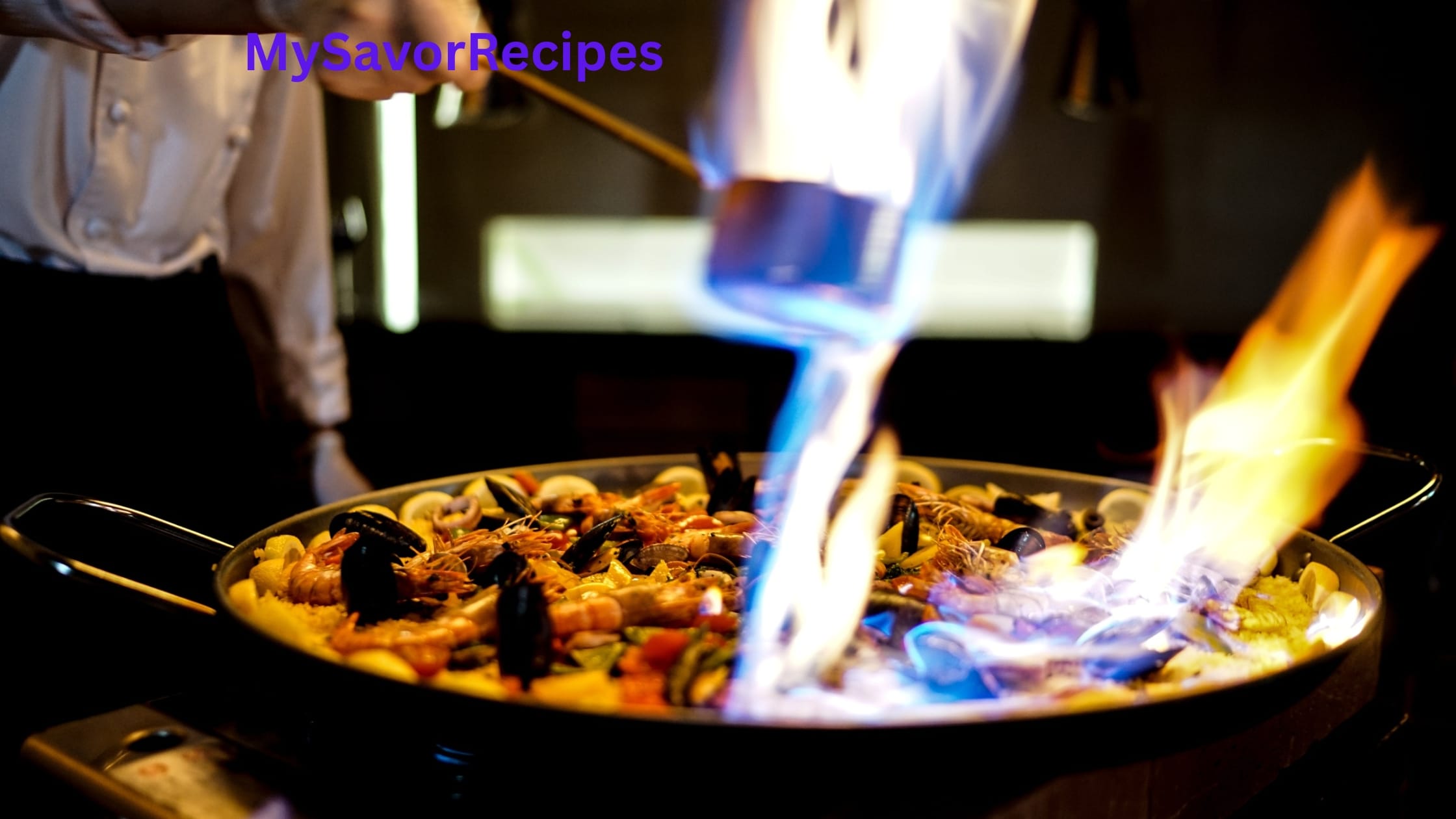
To make authentic seafood paella, you need the right ingredients. These ingredients bring the true taste of Spain to your kitchen. The key is to choose the right parts that work well together.
The heart of authentic seafood paella lies in its key ingredients:
- Rice: Short-grain Bomba or Calasparra rice is crucial. These special Spanish rice varieties absorb flavors while maintaining their texture
- Saffron: The golden spice that gives paella its distinctive color and rich flavor
- Fresh seafood selection: Shrimp, mussels, calamari, and local catch
Your seafood paella ingredients should include a flavorful base called sofrito – a mixture of onions, garlic, and tomatoes that creates depth in the dish. The quality of your fish stock can make or break the authentic seafood paella, so choose wisely.
Selecting the right seafood is an art form. Opt for the freshest local seafood you can find. Mixing different types of seafood adds complexity and richness to your paella. Think about combining:
- Succulent shrimp
- Tender calamari rings
- Fresh mussels
- Local white fish
Traditional Spanish chefs know that each ingredient is important. When these ingredients come together, they create a dish that tells a story of Spanish coastal cuisine.
Mastering the Art of Seafood Paella
Learning to make seafood paella takes skill, passion, and detail. This classic Spanish dish needs precision and a grasp of traditional cooking. Whether you’re cooking at home or dreaming of being a chef, learning seafood paella tips will change your cooking game.
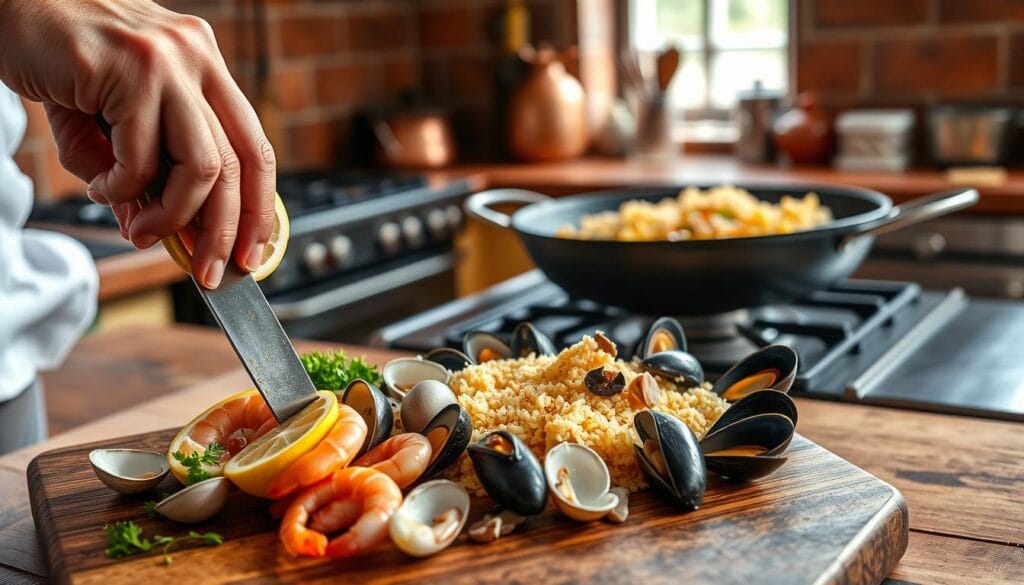
Making real seafood paella involves key steps that make the difference between a good dish and a great one. The right tools and techniques can turn your paella into something special.
Choosing the Right Paella Pan
Your paella pan, or paellera, is key to a perfect dish. Keep these points in mind:
- Choose a wide, shallow pan for even heat
- Opt for carbon steel for traditional cooking
- Make sure the pan fits your stove’s burner
- Look for a pan that lets rice spread thinly
Proper Rice Selection and Preparation
Rice is the heart of seafood paella. Here are some tips for authentic results:
- Use short-grain rice like Bomba or Calasparra
- Rinse rice lightly to keep starch
- Measure liquid carefully – 3 parts for 1 part rice
- Spread rice evenly for even cooking
Achieving the Perfect Socarrat
“Socarrat is the soul of paella – that crispy, caramelized rice layer every true paella lover craves.”
To get the legendary socarrat, follow these steps:
- Use high heat in the final cooking stage
- Listen for a gentle crackling sound
- Watch for golden-brown edges
- Avoid stirring rice in the last minutes
Mastering these techniques will help you make a stunning seafood paella. It will capture the essence of Spanish coastal cuisine.
Best Seafood Combinations and Regional Variations
Spain’s coastlines are home to a wide variety of seafood paella recipes. Each region adds its own special touch to this classic dish. This creates a culinary journey through Spain’s rich food culture.
When making the best seafood paella, consider these popular mixes. They show off the richness of Spanish coastal food:
- Valencian Seafood Paella: Combines prawns, mussels, and calamari with traditional rice
- Catalonian Black Paella: Features squid ink rice with mixed seafood
- Andalusian Coastal Paella: Includes local catches like red mullet and langoustines
An easy seafood paella recipe often mixes shellfish. Good seafood combinations include:
- Large shrimp
- Fresh mussels
- Tender calamari rings
- Small clams
Regional variations show the amazing diversity of Spanish paella. From the Mediterranean to the Atlantic, each area has its own seafood and cooking styles. This makes each dish unique and tasty.
“The secret to an amazing seafood paella lies in the freshness of your ingredients and the love you put into preparing it.” – Spanish Culinary Tradition
Conclusion
Learning to make Spanish seafood paella is more than cooking. It’s about connecting with Spain’s coastal traditions. You’ll learn its history, pick the best ingredients, and master techniques to make it special.
Creating authentic seafood paella takes time and effort. With each try, you’ll get better at cooking seafood, making the perfect crust, and mixing flavors. It’s all about being curious and respectful of Spanish cooking ways.
Seafood paella is best shared with others. It brings people together, whether it’s for a big event or a simple dinner. Your homemade paella will be a feast of flavors and a celebration of culture and connection. Start cooking, trust yourself, and let Spanish cuisine inspire you.
Now you’re ready to make a delicious paella that respects its roots but also has your own twist. Enjoy every step, relish each bite, and keep exploring Spanish cooking.


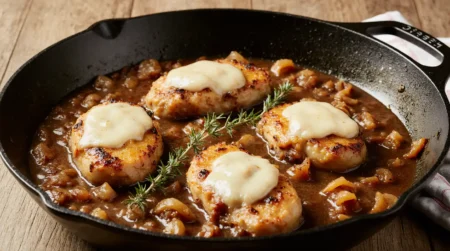
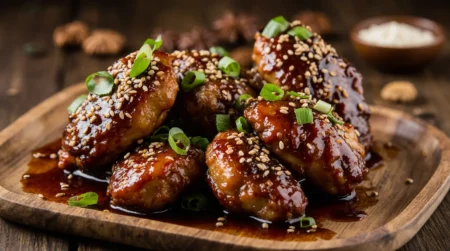
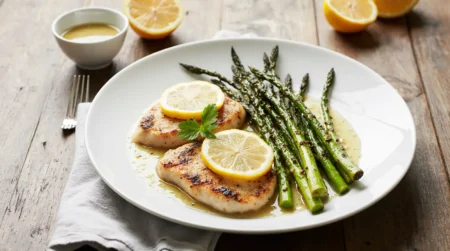
1 Comment
b4r9j0